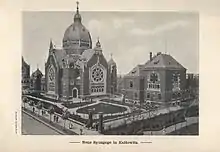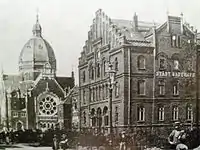| Great Synagogue of Katowice Synagoga Wielka w Katowicach Große Synagoge in Kattowitz | |
|---|---|
 | |
| Religion | |
| Affiliation | Judaism |
| Status | Destroyed in 1939 |
| Location | |
| Location | Katowice |
| Architecture | |
| Architect(s) | Max Grünfeld |
| Style | Gothic Revival, Renaissance Revival |
| Completed | 1900 |
| Dome(s) | 1 |
Great Synagogue was the largest synagogue in the city of Katowice (Kattowitz), in southwestern Poland. It was erected in 1900 in what was then the German Empire, and was designed by Max Grünfeld. The synagogue was set on fire by the Nazis in early September 1939 during the invasion of Poland.[1]
History
The plans to raise a new synagogue in Katowice arose around 1890, when the Old Synagogue (Katowice) became too small for the local worshippers. The construction begun in 1896, and the architect in charge was Max Grünfeld, son of Ignatz Grünfeld who designed the old synagogue. The construction was finished in 1900 and the synagogue was opened on 12 October 1900.[2]
The synagogue was set on fire by Nazis in early days of September 1939 after they gained control of the city during the invasion of Poland (1939); probably on 8 September.[1][3] After the war, the few Jews who survived the Holocaust were unable to gather enough resources and support to rebuild the synagogue. Today, a square (Synagogue Square) along with a small market occupies the place where this building once stood.[4] In 1988, a monument was raised in the square, dedicated to the Jewish inhabitants of the city who perished during the Second World War. There has been a series of plans to rebuild the synagogue in recent years, though none of them have yet proceeded to the implementation stage.[2]

Design
The brick synagogue was designed on the basis of a modified rectangle in style mixing Neo-Gothic with Neo-Renaissance, eclecticism and traces of Mauritian style; similar to the style of reformed Judaism synagogues in contemporary Germany.
The synagogue had a large dome with a cross-ribbed vault over the main prayer chamber which was preceded by a large entrance hall with offices and the chamber of marriage. The main chamber was topped with a lantern. Other characteristics elements included large decorated windows and small towers.
The main chamber could hold 1120 people; 670 men and 450 women.
References
- 1 2 (in Polish) 12.07.2005 Obrona Katowic we Wrześniu 1939 r. S 56.2003. Postanowienie o umorzeniu śledztwa. IPN. 2005
- 1 2 "Synagoga Wielka w Katowicach. Zabytek, którego już nie ma - Historia - polskieradio.pl". polskieradio.pl (in Polish). 12 October 2022. Retrieved 13 May 2023.
- ↑ Klaus-Dieter Alicke wrote (Lexikon der Jüdischen Gemeinden im deutschen Sprachraum, 2008, ISBN 978-3579080352): "die Synagoge [wurde] in Brand gesteckt – unter dem Vorwand, im Gebäude verborgene Heckenschützen unschädlich zu machen. Das Bauwerk brannte völlig nieder, seine Reste wurden danach abgetragen, nach Kriegsende die Freiflache teilweise überbaut." (.. was set on fire - under the pretense to dispose snipers hidden in the building. The fire destroyed the building completely; the remains were removed. After the war, the free area was partially covered with buildings)
- ↑ Jedlecki, Przemysław (7 May 2012). "Plac Synagogi może być dumą Katowic". Wyborcza.pl (in Polish). Retrieved 13 May 2023.